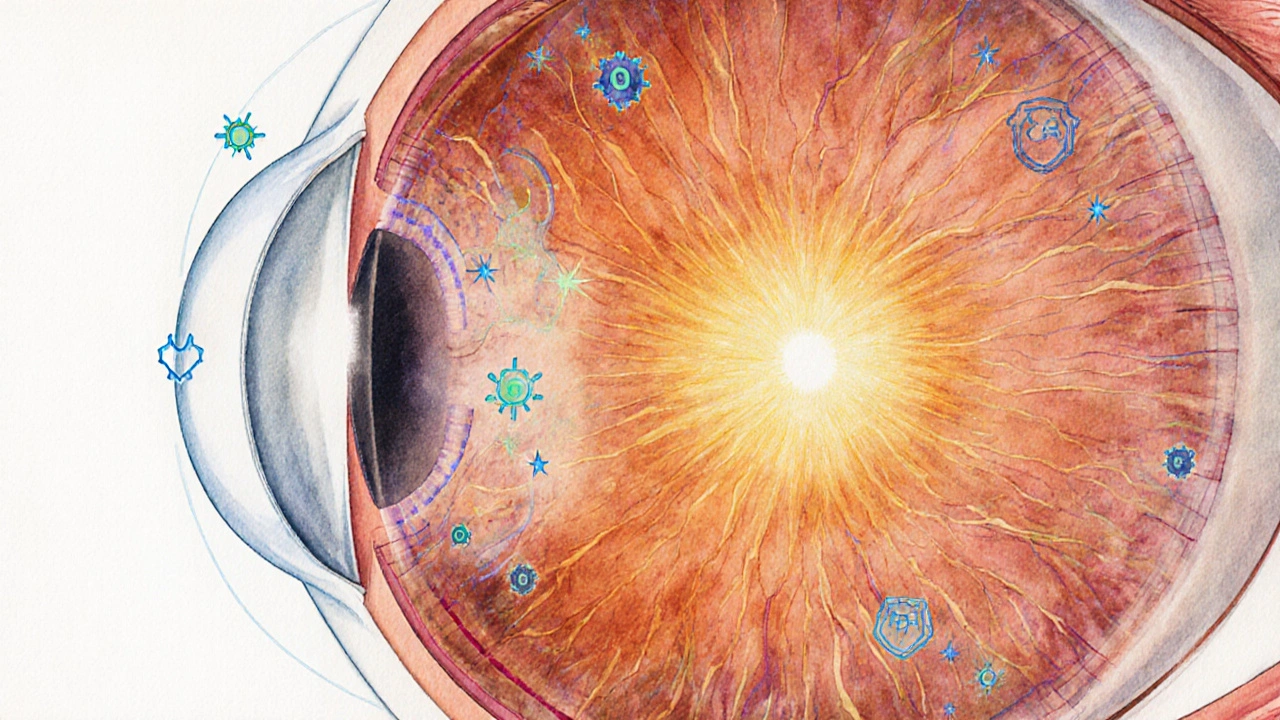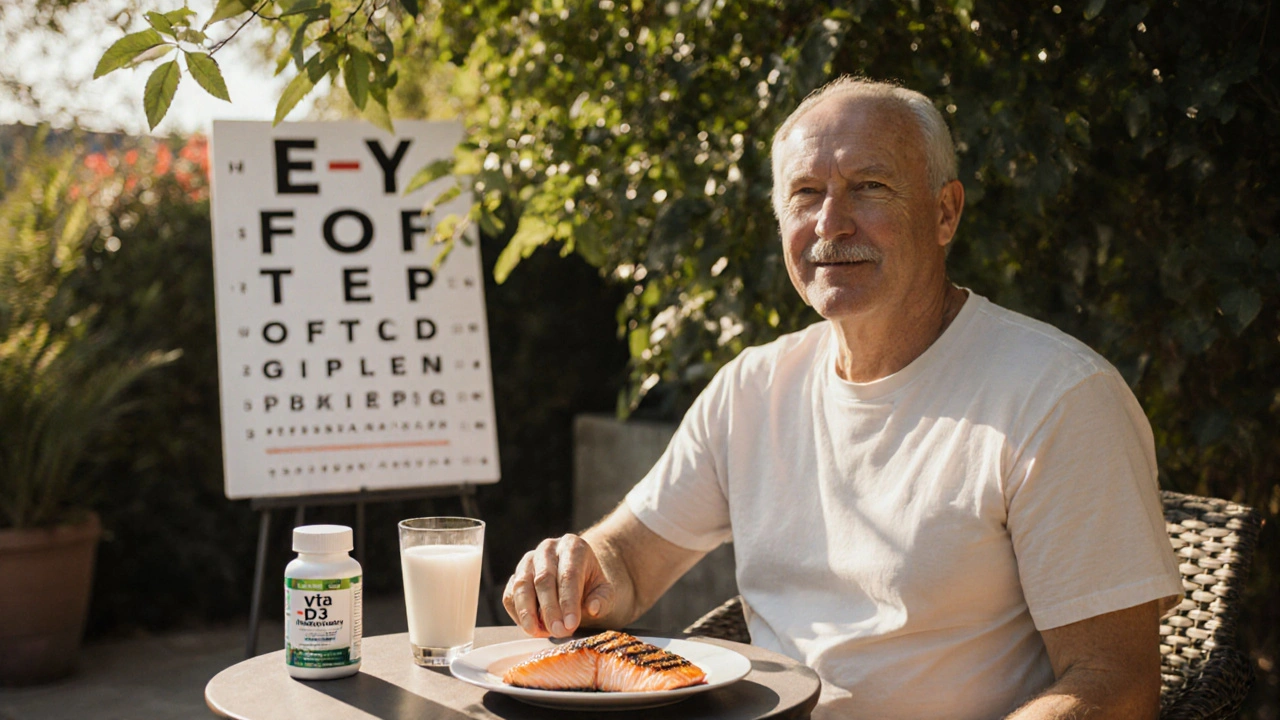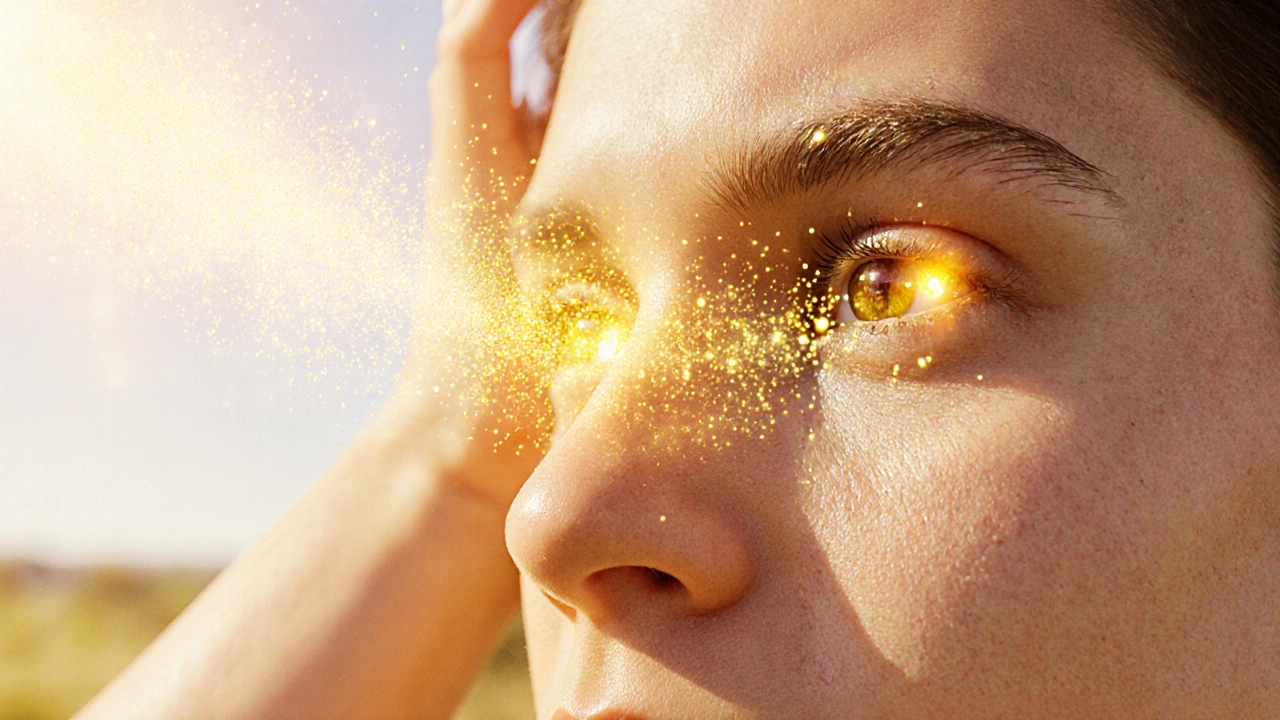Vitamin D Eye Health Calculator
Your Vitamin D Profile
Results & Recommendations
Enter your information above to see your vitamin D profile for eye health.
Key Takeaways
- Vitamin D supports the retina, macula and tear‑film stability.
- Low vitamin D levels are linked to higher risk of age‑related macular degeneration (AMD) and cataracts.
- Sunlight, fatty fish, fortified foods and supplements are the three main ways to meet daily needs.
- Most adults need 600-800 IU per day, but people with limited sun exposure may require more.
- Regular eye exams and a vitamin‑D‑rich diet together give the best protection.
What Vitamin D Does for Your Eyes
Vitamin D is a fat‑soluble nutrient that the body makes when UV‑B rays hit the skin. Beyond bone health, it acts like a hormone that talks to cells all over the body, including those in the visual system. When you hear "vitamin D", think of it as a signal‑boosting molecule that helps eye cells repair DNA, control inflammation, and keep blood vessels healthy. Without enough of it, the tiny photoreceptors in the retina start to age faster, and the protective barrier over the eye gets leaky.

How Vitamin D Interacts With Eye Structures
Retina is the thin layer at the back of the eye that turns light into nerve signals. Vitamin D receptors (VDR) sit on retinal cells, especially the retinal pigment epithelium (RPE), which feeds the photoreceptors. Activation of VDR triggers antioxidant enzymes that neutralise harmful free radicals generated by bright light.
The Macula is the central part of the retina responsible for sharp, colour vision. Studies from 2023‑24 show that people with serum 25(OH)‑D levels above 30ng/mL have a 35% lower incidence of early macular degeneration than those below 20ng/mL. The protective effect is thought to come from reduced inflammatory cytokines (like IL‑6) that would otherwise damage macular cells.
Cataract formation involves clouding of the lens, often linked to oxidative stress. Vitamin D boosts glutathione, a key antioxidant in the lens, slowing down the clouding process. A 2022 meta‑analysis of five randomized trials found a modest 12% reduction in cataract surgery rates among participants who took 1,000IU of vitamin D daily for three years.
Eye Conditions That Show Up When Vitamin D Is Low
Here’s a quick rundown of the most talked‑about eye problems tied to insufficient vitamin D:
- Age‑related macular degeneration (AMD) - The leading cause of vision loss in people over 60. Low vitamin D correlates with faster drusen accumulation and worse visual acuity.
- Dry eye syndrome - The tear‑film relies on a balanced inflammatory environment. Vitamin D deficiency can cause an over‑active immune response, leading to unstable tears.
- Glaucoma - Elevated intra‑ocular pressure isn’t the whole story; oxidative damage to the optic nerve also plays a role. Vitamin D’s neuroprotective properties may lower progression risk.
- Cataract - As mentioned above, the protective antioxidant effect slows lens opacity.
While vitamin D alone won’t cure these diseases, maintaining adequate levels is one of the easiest lifestyle moves you can make to reduce risk.
How to Get Enough Vitamin D for Eye Health
There are three reliable sources, each with pros and cons.
| Source | Typical Vitamin D Content | Additional Eye Benefits | Considerations |
|---|---|---|---|
| Sunlight (UV‑B 10‑30min, midday) | ≈5,000IU per hour (varies with latitude & skin tone) | Boosts nitric oxide, improves retinal blood flow | Risk of skin damage; limited in winter/southern latitudes |
| Fatty fish (salmon, mackerel, sardines) | ≈400‑600IU per 100g | Omega‑3s support tear‑film stability and macular health | Mercury concerns for high‑risk groups; cost |
| Fortified dairy/plant milks | ≈100‑150IU per cup | Calcium aids overall ocular tissue health | Added sugars in some brands; not enough for full requirement |
| Vitamin D3 supplement (cholecalciferol) | 1,000‑2,000IU per tablet (standard dose) | Predictable dosing; easy for people with limited sun | Potential toxicity if >4,000IU daily long‑term |
For most people living in New Zealand, a mix of safe sun exposure (10‑15 minutes a few times a week) plus two servings of oily fish per week covers the bulk of the requirement. If you’re rarely outdoors, especially during winter, a daily supplement of 800-1,000IU is a reliable backup.

Dosage, Safety, and When to Test
General guidelines (2024‑25 health authority updates):
- Adults 19‑70years: 600IU per day.
- Adults >70years: 800IU per day, because skin makes vitamin D less efficiently.
- People with diagnosed deficiency (<20ng/mL serum 25(OH)‑D): 1,500-2,000IU per day for 8‑12 weeks, then maintenance.
Vitamin D toxicity is rare but can happen if you consistently exceed 4,000IU without medical supervision. Symptoms include nausea, hyper‑calcemia, and kidney stones. That’s why a simple blood test is worth doing if you have any of the following:
- Limited sun exposure (e.g., indoor work, high latitudes)
- Dark skin tone
- History of osteoporosis or fractures
- Diagnosed eye conditions listed above
Ask your clinician for a 25‑hydroxyvitamin D test; results are reported in nanograms per milliliter (ng/mL). Aim for 30-50ng/mL for optimal eye health.
Quick Checklist: Protect Your Vision With Vitamin D
- Spend 10‑15minutes outdoors sunlight 2‑3 times a week (avoid midday burn).
- Eat two servings of oily fish each week OR use fortified dairy/plant milks daily.
- Consider a 1,000IU vitamin D3 supplement during winter months.
- Get a serum 25(OH)‑D test if you fall into any risk category.
- Schedule an eye exam annually; discuss vitamin D status with your optometrist.
Frequently Asked Questions
Can I get enough vitamin D from food alone?
Food alone usually provides 200‑400IU per day, which falls short of the 600‑800IU most adults need. Most nutritionists recommend supplementing or adding safe sun exposure to bridge the gap.
Is there a difference between vitamin D2 and D3 for eye health?
Vitamin D3 (cholecalciferol) is the form the skin makes and is more effective at raising blood levels. D2 (ergocalciferol) can be used, but studies show D3 offers better protection against inflammation in retinal cells.
How long does it take to see an effect on my eyes after fixing a deficiency?
Blood levels generally rise within 4‑8weeks of consistent supplementation. Visual symptoms like dry eye may improve in a similar timeframe, but structural changes (e.g., slowing AMD progression) are long‑term and best monitored over years.
What’s the safest way to get sunlight without harming my skin?
Expose face, arms, and hands for 10‑15minutes between 10am and 2pm, a few times per week. If you have fair skin, start with 5minutes and use sunscreen after the initial exposure window.
Can excessive vitamin D worsen any eye condition?
Very high doses can raise calcium levels, potentially leading to calcification in the retina or lens, though this is rare. Staying below 4,000IU daily and monitoring blood work prevents this risk.
Bottom line: Vitamin D is more than a bone‑builder; it’s a silent ally for the eyes. By checking your levels, eating smart, and catching a bit of sun each week, you give your retina, macula, and lens the support they need to stay clear for years to come.


20 Comments
Camille Ramsey
Look, vitamin D ain’t some magic unicorn, it’s just biochemistry. You’ll miss the point if you think sunlight is a cure‑all.
Scott Swanson
Sure, we all love a good miracle story, but the data shows you need a balanced approach: a bit of safe sun, oily fish, and when you’re indoor‑bound, a modest supplement. Skipping the supplement just because “the sun’s out” won’t cut it for most northern latitudes. Think of your eyes like a camera sensor – they need consistent maintenance, not occasional polishing. Also, remember that excessive UV can damage the cornea, so moderation is key. So, don’t throw away the supplement bottle just yet.
Karen Gizelle
It is morally incumbent upon us to prioritize evidence‑based nutrition over trendy fads. Vitamin D deficiency has been linked to ocular pathologies, and ignoring that fact borders on negligence. Let’s champion informed choices instead of chasing headlines.
Stephanie Watkins
The connection between retinal health and systemic nutrients is fascinating. Maintaining adequate vitamin D can complement regular eye exams and a balanced diet.
Zachary Endres
Exactly! I love seeing how a simple daily habit like a short walk in the sun can boost our vision and mood. It’s like giving our eyes a tiny standing ovation every day.
Ashley Stauber
Don’t be fooled by big‑pharma’s push for pills; most people can get enough vitamin D from natural sources without foreign additives. The market’s hype is just a cash grab.
Amy Elder
Sure, but some folks just can’t get reliable sun exposure, especially in winter, so a supplement isn’t a crime.
Erin Devlin
Sunlight is a photon‑rich teacher, yet we often ignore its lesson on ocular resilience.
Will Esguerra
When I first read about the silent erosion of the macula, I felt a chill crawl up my spine. The retina, that delicate tapestry of photoreceptors, does not forgive chronic neglect. Vitamin D, acting as a hormonal sentinel, modulates inflammation in ways that most of us barely comprehend. Without sufficient levels, oxidative stress gathers like storm clouds over the optic nerve. Studies from the past two years have repeatedly shown a statistical dip in age‑related macular degeneration among subjects with serum 25‑OH‑D above thirty nanograms per milliliter. Moreover, the lens, that transparent window, benefits from glutathione upregulation triggered by this fat‑soluble vitamin. In laboratory mice, vitamin D supplementation delayed cataract formation by twenty percent, a finding that translates intriguingly to human physiology. Yet the public discourse remains fixated on bone health, sidelining ocular implications. Clinicians, therefore, ought to incorporate vitamin D screening into routine ophthalmic evaluations. Patients, on their part, should be educated about safe sun exposure schedules tailored to skin type. Dietary sources-salmon, mackerel, fortified milks-provide a steady drip of the nutrient, but geographic latitude caps their efficacy. For those living in high‑latitude enclaves, a modest daily supplement of eight hundred to a thousand IU can bridge the gap. It is not a panacea, but it is a shield against the relentless march of degeneration. Ultimately, protecting our sight is a collective responsibility, intertwining nutrition, lifestyle, and preventive care. So, let us not dismiss vitamin D as merely a bone‑builder; it is a guardian of our visual world.
Allison Marruffo
Well articulated! Your thorough rundown makes a compelling case for integrating vitamin D checks into eye‑care protocols.
Tom Haymes
Balancing sun exposure with skin cancer risk remains a nuanced challenge for many.
Scott Kohler
Oh sure, because the global elite want us all blinded by cataracts while they hoard the supplement patents. It’s all a grand design, isn’t it?
Noah Bentley
i think u should read the peer‑reviewed studies before spouting opinions about vitamin d.
Kathryn Jabek
While your casual tone is noted, it is imperative to reference empirical evidence rather than resort to colloquial admonitions.
Ogah John
In the tapestry of health, each micronutrient is a thread; pull one too loosely, and the pattern unravels.
Kelvin Murigi
Precisely, clinical guidelines now suggest routine serum 25‑OH‑D testing for patients at risk of ocular degeneration, and supplementation can be tailored accordingly.
Chester Bennett
Great discussion, everyone. It’s encouraging to see the community focus on preventive eye health.
Emma French
Absolutely, let’s keep sharing practical tips and solid data so folks can make informed choices.
Rohit Poroli
Leverage photobiomodulation protocols alongside optimal vitamin D levels for synergistic retinal resilience.
jenni williams
Love the idea 😊 integrating sun‑derived photobiomodulation with nutrition for eye health.